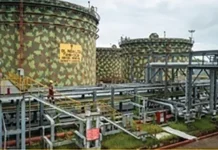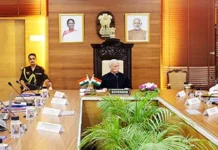[ Tongam Rina ]
ITANAGAR, Jul 17: The Centre has approved the 2880 MW Dibang Multipurpose Project, paving way for the construction of the world’s tallest concrete gravity dam at a staggering 278 metres on the Dibang River by the National Hydroelectric Power Corporation (NHPC) without the final forest clearance.
On Wednesday, the Cabinet Committee on Economic Affairs, which was chaired by Prime Minister Narendra Modi, approved the expenditure on pre-investment activities and various clearances for Dibang Multipurpose Project for an amount of Rs 1600 crore.
The estimated completion period for the project has been fixed at nine years from receipt of government sanction.
The Press Information Bureau (PIB), Government of India, in a press release said that the estimated total cost of project is Rs 28080.35 crore, including Interest During Construction (IDC) and Financing Charges (FC) of Rs 3974.95 crore at June 2018 price level.
The project shall generate 2880 MW (12x240MW) power to produce 11223 MU of energy in a 90 percent dependable year, the release added.
On completion, the Government of Arunachal Pradesh will get 12 percent free power from the project, while one percent free power will be given to local area development fund (LADF).
“The total value of benefit to Arunachal Pradesh from free power and contribution to the LADF will be Rs 26785 crore over the project life of 40 years”, the release said.
The Dibang MPP would be a storage based with flood moderation as the key objective.
Project yet to get final forest clearance
While all statutory clearances, including environment clearance, forest clearance (Stage-l) defence clearance and techno-economic clearance has been granted, the stage-II forest clearance is yet to be accorded.
The final forest clearance is given when the state government issues order to divert forest land after central government gives stage – II forest clearance.
The total land requirement for the project is about 5349.14 ha, which includes unclassified state forest, community land, and wet rice cultivation areas.
The total submergence area is 3564 ha, which includes 1176 ha of river bed. The total catchment area of the project is 77,276 sq kms.
Rs 500.40 crores has been projected for compensation for land acquisition and relief & rehabilitation (R&R) activities to project affected families and state government, payment of net present value of forests, compensatory afforestation, catchment area treatment plan
to the state government for forest lands, to secure the forest clearance (Stage-lI) and construction of roads and bridges for accessing project site.
In addition to the mandated R&R plan, it is also proposed to spend Rs 241 crore on community and social development plan and certain concerns raised by the local people during the public hearings.
An amount of Rs 327 lakhs is proposed on a plan for protection of culture and identity of local people.
CM, DCM welcome cabinet decision
Chief Minister Pema Khandu has welcomed the cabinet decision.
“I wholeheartedly thank Govt of India for approving India’s highest dam #DibangMultipurposeProject in Arunachal. With estimated cost of more than Rs 28000 Cr, the project on completion will bring huge revenue to state & open floodgate of economic opportunities & tourism activity,” he tweeted.
The deputy chief minister has also thanked the Government of India for approving the highest dam of the country.
“On completion, this power project will highly boost the economic development of the state,” he tweeted.
Both the leaders did not comment on the cascading effect the project would have on the environment.
Concrete gravity dam near confluence of Ashu Pani and Dibang
The Dibang Multipurpose Project is proposed on the Dibang River near Munli village, about 43 kms from the district headquarters of Roing in Lower Dibang Valley district.
The 278 mtrs high concrete gravity dam will be across the Dibang River, about 1.4 kms upstream of the confluence of Ashu Pani River and Dibang River.
Substandard studies
Right from the beginning, the project has been controversial because of substandard studies.
The project was rejected twice by the ministry’s Forest Advisory Committee (FAC).
It was first rejected in July 2013 although it was under pressure from the Cabinet Committee on Investment (CCI), headed by the UPA prime minister to grant the clearance.
The FAC, while rejecting the proposal had observed that the “ecological, environmental and social costs of diversion of such a vast track of forest land, which is a major source of livelihood of the tribal population of the state, will far outweigh the benefits”.
Ultimately, the environmental clearance was granted in February 2015 by the ministry.
In November last year, the National Green Tribunal (NGT) had upheld the environmental clearance (EC) which was given under questionable circumstances, according to experts.
While disposing of appeals filed by Pradip Kumar Bhuyan versus Union of India and Ors and Pradip Bhuyan & Anr versus Union of India and Ors questioning the grant of environmental clearance by the Environment, Forests & Climate Change (EF&CC) ministry in February 2015, an NGT bench comprising Justices Adarsh Kumar Goel, Jawad Rahim and SP Wangdi, and technical member Dr Nagin Nanda on 13 November, 2015 ruled that “adequate studies and steps had been undertaken to ensure sustainable implementation of the project.”
It said that expert studies have been undertaken over a period of almost 14 years, starting in 2004.
“Multiple individual experts, expert bodies and institutions have expressed their opinion after undertaking detailed scientific and technical studies which we find difficult to brush aside,” it said.
It had said that “no activities which would ultimately lead to unscientific and unsustainable development and ecological destruction should be allowed at all and must scrupulously try to protect the ecology and environment. Harmonization of… issues of the ecology and developmental project has to be ensured. In the present case, we find adequate steps having been taken towards this direction”.
Protests by citizens
Before the clearance was granted on 19 February, 2015, by the EF&CC ministry, the project had witnessed massive protests by the local people, which had led to multiple postponements of public hearings. The public hearings were postponed several times between 2008 and 2013 due to stiff protests by the Mishmi community.
Controversially, most of the public hearings cancelled were blamed on bad weather conditions. Finally, two public hearings were held in the first quarter of 2013 for Lower Dibang Valley and Dibang Valley districts, where the public was reported to have agreed to the project.
According to studies, 115 families of five villages are likely to be displaced, and 744 families of 39 villages are likely o be affected due to acquisition of land.
The loan
On the other hand, in 2007, the Government of Arunachal Pradesh had taken a loan of Rs 225 crores from the NHPC at nine percent interest per annum to revive the sick Arunachal Pradesh Cooperative Apex Bank Limited.
One of the project against which the loan was taken out was the Dibang multi-purpose project.




